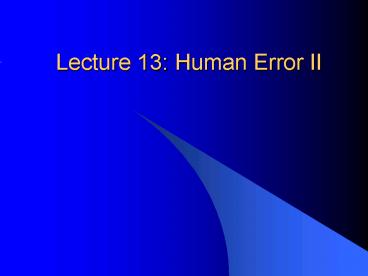Lecture 13: Human Error II - PowerPoint PPT Presentation
1 / 18
Title:
Lecture 13: Human Error II
Description:
A-10 ~33% unavailable at any one time. F-111D ~66% unavailable. ... Check out the requirements. First deliverable is the project proposal ... – PowerPoint PPT presentation
Number of Views:38
Avg rating:3.0/5.0
Title: Lecture 13: Human Error II
1
Lecture 13 Human Error II
09/10/99
2
Goals
- Overview of system error
- Review of results and findings
3
System Error
- DEFINITION an action or lack of action that
violates some tolerance limit(s) of the system.
- defined in terms of system requirements and
capabilities. - Does not imply anything about human. - could be a
system flaw - Error probability (EP) also known as Human Error
Probability (HEP) - EP ( of errors)/(total of opportunities for
the error)
09/10/99
4
Reliability
- DEFINITION Probability of a successful outcome
of the system or component - To evaluate a system it is necessary to know the
goals and purposes of the system. - Reliability is a probabilistic term.
5
Calculation of Reliability
- R ( of successful operations)/(total
of operations) - R 1 - EP
6
Basic Error Types (system perspective)
- Unintentional vs. Intentional
- e.g. mistake on a test vs. what speeds most of
us drive. - Unrecovered vs. Recovered
- Recovered Error with possibility for damage but
no damage e.g., Driving home drunk safely. - Unrecovered Error where damage could not be
avoided.
7
Human Error Categories
- Error of Omission
- typographical errors
- Error of Commission
- Hitting thumb with the hammer
- Extraneous Act
- reading a different class's assignment in class
- Sequential Error
- E.g., light the fire before opening the damper
- Time Error
- running a red light
8
Where the Error Originates
- Operating error
- Design Error
- Designer does not take into account
human abilities. - Manufacturing Error
- System is not built according to design.
- Installation and Maintenance Errors
- System is not installed or maintained
correctly.
9
Relative Frequency of Error Types
- Failure to perceive a hazard
- 36
- Underestimate a hazard
- 25
- Failure to respond
- 17
- Ineffective response
- 14
10
Error Analysis
- 1.Describe system goals and functions.
- 2.Describe situation.
- 3.Describe tasks and jobs.
- 4.Analyze tasks for where errors are likely.
- 5.Estimate probability of each error.
- 6.Estimate probability error is not corrected.
- 7.Devise means to increase reliability
- 8.Repeat step 4 - 7 in light of changes.
09/10/99
11
Example Human Error Probabilities (HEPs)
- Select wrong control in group of labeled
identical controls -
.003 - Turn control wrong direction under stress
when design violates population norm. -
.5 - Failure to recognize an incorrect status of
item in front of operator -
.01
12
Components in Series
- In a series if any single component fails the
whole system fails e.g., the four tires on a
car. - Rs R1 R2 ....... Rn
- Examples All components have reliability of
0.90. - n 1 Rs .90 n 2 Rs .9.9 .81
- n 3 Rs .9.9.9 .73
09/10/99
13
Redundancy and Reliability
- Active Redundancy Failure occurs only when both
fail or (EP1)(EP2) - Reliability is Rs R1 R2 - R1R2
- E.g., two components have a reliability of 0.90.
- In a series Rs .9.9 .81
- Redundant Rs .9.9-.9.9 .99
- Two redundant components in series
- Rs .99.99 .98
14
Perils of Complexity
- KISS Principle (Keep It Simple Stupid).
- A-10 33 unavailable at any one time.
- F-111D 66 unavailable.
- Apache Helicopter has a similar record to the
F-111D
15
Risk Analysis
- Estimates of safety
- Estimates of probable success
- types of training to use to help operators not to
miss important errors
16
Lessons
- System error analysis different from human error
analysis - Redundancy increases reliability
- Complex systems tend to be less reliable
- Error and Risk analysis are useful activities
17
Project
- Project description is on the Web
- Check out the requirements
- First deliverable is the project proposal
- If your group has not started meeting about the
project you have a problem. - Tomorrows lecture is a review for the midterm
exam
18
Tutorial/Exam
The midterm exam will be held during this weeks
tutorial, But in a different location (WW 111)































